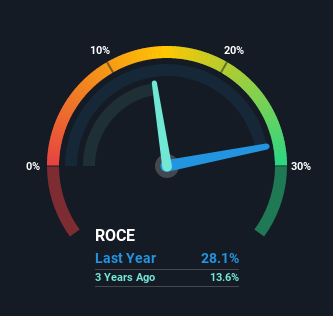If we want to find a potential multi-bagger, often there are underlying trends that can provide clues. Ideally, a business will show two trends; firstly a growing return on capital employed (ROCE) and secondly, an increasing amount of capital employed. If you see this, it typically means it's a company with a great business model and plenty of profitable reinvestment opportunities. So when we looked at the ROCE trend of EssoF (EPA:ES) we really liked what we saw.
What is Return On Capital Employed (ROCE)?
Just to clarify if you're unsure, ROCE is a metric for evaluating how much pre-tax income (in percentage terms) a company earns on the capital invested in its business. To calculate this metric for EssoF, this is the formula:
Return on Capital Employed = Earnings Before Interest and Tax (EBIT) ÷ (Total Assets - Current Liabilities)
0.28 = €456m ÷ (€3.3b - €1.7b) (Based on the trailing twelve months to June 2021).
So, EssoF has an ROCE of 28%. That's a fantastic return and not only that, it outpaces the average of 8.9% earned by companies in a similar industry.
View our latest analysis for EssoF

While the past is not representative of the future, it can be helpful to know how a company has performed historically, which is why we have this chart above. If you want to delve into the historical earnings, revenue and cash flow of EssoF, check out these free graphs here.
What Does the ROCE Trend For EssoF Tell Us?
We're delighted to see that EssoF is reaping rewards from its investments and has now broken into profitability. Historically the company was generating losses but as we can see from the latest figures referenced above, they're now earning 28% on their capital employed. At first glance, it seems the business is getting more proficient at generating returns, because over the same period, the amount of capital employed has reduced by 24%. The reduction could indicate that the company is selling some assets, and considering returns are up, they appear to be selling the right ones.
For the record though, there was a noticeable increase in the company's current liabilities over the period, so we would attribute some of the ROCE growth to that. Essentially the business now has suppliers or short-term creditors funding about 51% of its operations, which isn't ideal. And with current liabilities at those levels, that's pretty high.
The Bottom Line
From what we've seen above, EssoF has managed to increase it's returns on capital all the while reducing it's capital base. And since the stock has fallen 52% over the last five years, there might be an opportunity here. With that in mind, we believe the promising trends warrant this stock for further investigation.
EssoF does have some risks, we noticed 2 warning signs (and 1 which doesn't sit too well with us) we think you should know about.
EssoF is not the only stock earning high returns. If you'd like to see more, check out our free list of companies earning high returns on equity with solid fundamentals.
Valuation is complex, but we're here to simplify it.
Discover if EssoF might be undervalued or overvalued with our detailed analysis, featuring fair value estimates, potential risks, dividends, insider trades, and its financial condition.
Access Free AnalysisHave feedback on this article? Concerned about the content? Get in touch with us directly. Alternatively, email editorial-team (at) simplywallst.com.
This article by Simply Wall St is general in nature. We provide commentary based on historical data and analyst forecasts only using an unbiased methodology and our articles are not intended to be financial advice. It does not constitute a recommendation to buy or sell any stock, and does not take account of your objectives, or your financial situation. We aim to bring you long-term focused analysis driven by fundamental data. Note that our analysis may not factor in the latest price-sensitive company announcements or qualitative material. Simply Wall St has no position in any stocks mentioned.
About ENXTPA:ES
EssoF
Esso S.A.F. refines, distributes, and markets oil products in France and internationally.
Excellent balance sheet and good value.
Similar Companies
Market Insights
Community Narratives



